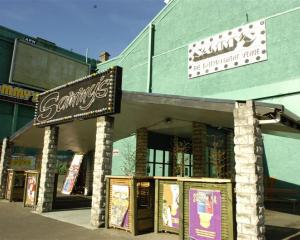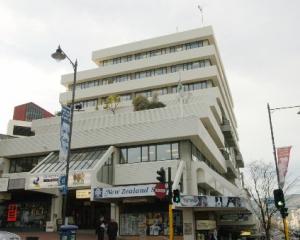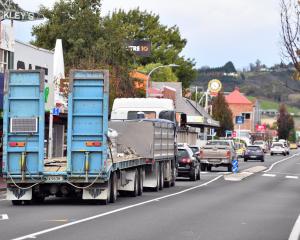It's 6pm midweek. It's pitch black and rain is sweeping in from Otago Harbour and across Portsmouth Dr.
And there's Russell Walker, on his bike, heading home. He's an Australian electrician who came to Dunedin for the weather. But more about him later.
For every two Russell Walkers there are 60 Dunedin commuters with their windows wound up; wipers flicking away the raindrops.
The Dunedin City Council keeps count and although it would not make its yet-to-be analysed raw data available to the Otago Daily Times, there seems little doubt cyclists are on the rise.
In 2004, following the Labour government's lead, the council created a Dunedin Cycle Strategy to "encourage participation" in cycling and "address" cycling safety.
It provided a vision, outcomes, targets and objectives.
One of them was to increase the length of cycle lanes by 5km a year.
In three of the subsequent four years, the target was not achieved.
Senior traffic engineer Bruce Conaghan believes the targets were "overly optimistic".
"It's not just a matter, in some cases, of slapping paint on the road and, I think, maybe that's where the original thinking was coming from."
Other targets seem also not to have been achieved and now the council is rethinking its strategy.
Senior transportation planner Sarah Weller is in charge of the process and a Christchurch consultant (Abley Transportation Consultants) is being paid $27,000 to produce, among other things, an "inventory" of Dunedin's cycling facilities "... so we know exactly what we've got and where it is and where the gaps are".
The council knows already it has 43.3km of cycleway - mostly (31.3km) consisting of painted lanes on roads. There is also 200m exclusive to cyclists and 12km they share with pedestrians.
And, via public consultation, the council is regularly reminded where it is considered to be coming up short.
Ms Weller: "I think there has been a lot of pressure put on the council to do more and I think the council has responded really positively to that by doing more."
"We get people that see it as just a roading improvement. The reality is that it is an improvement for all users.
"It would certainly cost a heck of a lot less if we didn't put in this huge cycleway/walkway."
Putting a cycleway/walkway around the entire shoreline of Otago Harbour is one of the current council commitments.
Investigating a cycle link to Mosgiel is another.
And there's one more thing.
The ODT has been shown a map of the city with "indicative" lines drawn where "strategic routes" for cycling could be established, just as they have been for cars.
Ms Weller said the idea had not yet been put in front of cycling groups but she was "quite excited" by the prospect of the strategic routes " ... where we invest money so cyclists know it's going to be a high-standard facility".
It is an idea with a familiar ring.
In 2001, then mayor Sukhi Turner responded to a cycle protest over the death on Portsmouth Dr of New Zealand cycling representative James Faulding by saying the council was preparing an "indicative" cycle network and consultants were to be chosen.
Ms Weller, who has been with the council for four years, said she would not provide a copy of the latest map because it was still "internal" and had not been to the council.
But the copy the ODT saw appeared to show strategic routes that include the more obvious links to the peninsula and Port Chalmers as well as one up Northeast Valley, one along the line of the new Caversham highway, one along the coast from St Clair to Lawyers Head, and one from somewhere on Victoria Rd through South Dunedin.
The consultants have been asked to do something similar in Mosgiel.
Ms Weller said the strategic routes were an alternative to spreading cycling money "more thinly" across the city and would enable the council to "really focus" improvements on these routes.
"So this is the start of a proper cycling network."
Asked whether the routes would be dedicated exclusively to cycling, Mrs Weller said: "I think that is to be decided yet but I think it would be unlikely they would be separate from cars.
"But I see it as making them much more safe and attractive for cyclists to use."
Creating strategic cycle routes - giving more space to cyclists - would likely mean others having to give up some of their space.
Mr Conaghan uses North Rd, through Northeast Valley, as an example.
Its current cycleways - two white lines with traffic on one side and parked cars on the other - can seem quite narrow to cyclists wary of motorists opening car doors in front of them.
"Now, maybe longer term, you may have to take out parking," Mr Conaghan says.
After all, providing motorists with "on-street" parking is not one of council's functions.
"Never has been; never will be. It's a privilege, not a right."
But he points out that while removing parked cars might solve one problem, it could open up another.
Rows of parked cars generally tend to "moderate" motorists' speed.
Take them away and traffic on North Rd can be expected to speed up.
"So when we do these things, we have to think about all of the users and the effects - if I do this, what effect is it going to have on somebody else?"
Ms Weller notes the things other cities have done, such as giving cyclists a head start at traffic lights, providing better signs, and requiring new buildings to have cycle parking.
"We have got a plan change going through, hopefully next year, which should enable us to put some of those things into the district plan," she said.
It took four years to finalise the first strategy and, six years later, the jury is still out on how far its "vision" has been advanced.
Is Dunedin "a safe and pleasant city for cycling, where people of all ages choose to cycle for transportation, access, health and recreation"?
Has the proportion of cycling commuters been increased to 4.9% (from 2.9% in 2001)?Has the number of people cycling for health and recreation been increased?
Have casualties from crashes between cycles and cars been decreased by 6% a year?And, has the council been spending $100,000 a year on cycling infrastructure?
The answers to some of those questions may be contained in the Christchurch consultant's report due in September.
In the meantime, the ODT has been on the cycleways taking the pulse of the city's cyclists.
Depending on which commercial premises he is working on and which way the wind is blowing, the trip takes him 15 to 20 minutes.
"I don't see why more people can't do it. It's not hard."
Generally, he carries the tools of his trade with him.
"Sometimes when I need more tools I'll get someone to take the tools to the job. But more often than not, I can carry all the tools I need on my bike."
Mr Walker does own a car but enjoys the fact he is "one less car on the road ... one less car you have to find a park for".
To keep warm in winter, he wears layers of woollen clothing.
"I've never worn that lycra stuff in my life... Can't see why you need to wear it to go cycling."
Mr Walker would like the council to open up to cyclists the two old railway tunnels between Dunedin and Mosgiel and "squeeze in" more cycle lanes on roads.
There should also be better signage, he believes, and more education programmes for motorists and cyclists.
"There are a lot of cyclists out there who are not sensible. They cut corners or race the lights. You've just got to be sensible."
From the rafters hang used frames, tyres and tubes; shelves are sparsely stacked with tools and second-hand bicycle parts and in one corner, a record player schmoozes out the jazz from an old LP.
This is "The Crooked Spoke", which operates on the smell of an oily rag and a large ration of good will.
Chris Schmelz and Simon Hellyer set up the do-it-yourself bicycle workshop to provide cyclists with free use of tools and access to the collective repair skills of whoever happens to be around at the time.
Messrs Schmelz and Hellyer are into "skill sharing", recycling and making cycling more accessible as transport for those on limited incomes.
Mr Schmelz believes the best contribution the council could make to cycling would be to put more effort into "trying to change drivers' attitudes" towards cyclists.
"I don't know how you would go about that but at the end of the day that's what needs to happen."
Mr Schmelz is not a great fan of cycle lanes and considers those along Dunedin's one-way streets are "really, really dangerous".
"You've got all the sheep trucks and logging trucks flying past and because there's that solid white line there they don't feel they need to change their behaviour. You are sort of trapped between a parked car and moving traffic."
For 35km they battle the hills, the potholes, the grit, the rumble strip, the easterly, the sou'westerly and the nor'westerly. And the traffic.
What began three years ago as four women on bikes has "blossomed" into a twice-weekly event that can include up to 30.
Rachael Jackson was one of the originals.
"We just used to go out and have a wee ride together whenever we could and then [husband] Steve decided to come with us."
Steve Dyet, co-owner of Browns Avanti Plus Cycle Specialists, says when the women started they did not know how to ride.
"They were just like mad women. They were all over the place and in the wrong gears."
Ms Jackson says the women took her husband's advice and now bunches of up to 10 "whizz" along the low road to Portobello and back over the high road.
"The advantage is, when it's really windy, you've got more people to help you out and when you're riding in a group I think you are seen better on the road."
Mr Dyet says they're a "tough" bunch and "very resilient" and not much will stop them but Ms Jackson believes "a lot" of motorists do not accept cyclists should be on the road and she expects one particular bus driver "will probably knock one of us over one day".
Other "grumpy old men" will sit "right on your tail" or get in the way as they overtake.
She believes the council could help cyclists by running an education programme explaining to motorists that cyclists are entitled to ride two abreast (not that Ms Jackson's group does) and that motorists must be 1.5m from cyclists when they overtake.
Mr Dyet believes North Islanders more used to traffic delays are more tolerant of cyclists than Dunedin drivers, and the council could help by erecting more "share the road" signs.
Brother of the more famous Greg, Mr Henderson is president of Cycling Otago and, ironically, a car salesman.
But after work, in the gathering winter gloom, he will be on his bike heading for Waitati, Portobello or Outram.
"I just love it. I can have the worst day at work; I leave here at 5 o'clock on my bike and after a couple of hours anything bad that happened has just melted away.
"In the winter it's quite surreal. If we go out training it's peaceful and it's quiet and it's just you and the dark on the bike - with plenty of lights obviously."
Mr Henderson has been clocking up 500km a week for the past three years and puts his survival on darkened Dunedin streets down to defensive driving habits he developed as a motorcyclist.
"You've just got to give motorists a little more respect than perhaps they give us."
That means anticipating problems, giving himself room to manoeuvre, keeping his fingers near the brakes and carrying two red rear lights to give himself "a better opportunity" of being seen from behind.
"There is obviously the motorist who thinks they're pretty clever and comes past as close as they can and jumps on the horn just at the last minute because that's obviously pretty funny for them.
"That's probably the most dangerous thing we come across."
Mr Henderson says he had his closest call with a trailer at Ocean View - the driver of the vehicle towing the trailer not allowing for its extra width.
He believes the council is heading in the right direction by providing more cycle lanes and widening road shoulders on more popular cycle routes.
The New Zealand Transport Agency's widening of State Highway 87 near Outram provided "a whole lot more room to ride to the left of the white line".
And the "pretty dangerous" ride to Portobello, on a route named by Lonely Planet as the best ride in the world, is being improved with a cycle lane.
"Even though it's only a painted line, it just does give you a wee bit more security.
"So I think if they continue on with where they are heading we are more than happy."
With 20 years of motorcycling behind him, and a girlfriend threatening to leave if he bought another one, Mr Angelo spent $3000 on a top-of-the-line Wisper electric bicycle - a "normal" bicycle that helps with pedalling.
"It helps me out enough that with a bit of huffing and puffing I can get to the top of Pine Hill.
"And I've gone crazy on it. I love it."
Mr Angelo, a diabetic, was advised to buy the bike by his doctor and now rides it to his IT job at the university every day.
The Wisper has a range, he estimates, of about 40km, although if he lived on the flat and was "more svelte" he believes he might get 80km between charges.
Mr Angelo believes the biggest cycling problem in Dunedin is other cyclists who don't use lights and do "dodgy stuff".
He finds drivers "really polite" and believes that may be because so many motorists also cycle at times.
He considers cycle lanes painted on roads "useful" but the council needed to create more cycleways separate from cars.
"We have plenty of roads where we could do something like that."
• CRASHES
In 1999, a 32-year-old woman was sentenced to 100 hours' community service in the Dunedin District Court on a charge of careless use of a motor vehicle causing death.
She had opened her car door in front of cyclist Dr Jan Breward who then fell under a truck and was killed.
Because of what her lawyer described as a "slight error", the woman was left with a $29,000 legal bill, a broken marriage, insolvency and psychological damage.
Since then, seven cyclists have died in Otago and 540 crashes have been reported to police.
The number of cyclists seriously injured is 106 and the number who suffered minor injuries 342.
The NZTA suggests only 50% to 60% of crashes are reported.












